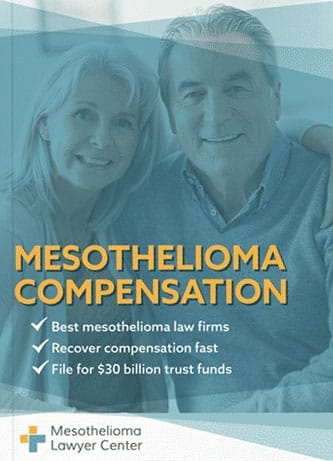Insulators install, remove, and replace insulation in various work settings. A lot of insulation was once made with asbestos, putting these workers at high risk for asbestos exposure. Current workers still face risks when working in older buildings with outdated asbestos insulation.
If you or a loved one have been diagnosed with mesothelioma, asbestosis, or asbestos-related lung cancer, you may be eligible for substantial compensation. There is currently over $30 billion in asbestos trust funds set up for victims of asbestos-related diseases. We invite you to fill out our form today for a free Financial Compensation Packet, filled with information about experienced mesothelioma lawyers in your area, how to get paid in 90 days, how to file an asbestos trust fund claim, and much more.


FREE Financial Compensation Packet
- Info on law firms that will recover your HIGHEST COMPENSATION
- Learn how to get paid in 90 days
- File for your share of $30 billion in trust funds
How Insulation Workers Are Exposed to Asbestos
Insulation workers install, replace, and repair insulation materials, many containing asbestos. According to the Bureau of Labor Statistics, insulators typically work indoors and in confined spaces where insulation materials, including asbestos, getting in the eyes, lungs, and hair.
- Asbestos was heavily used in construction until about the 1970s. At that time, the dangers became more well-known, and companies began phasing it out. One of the most common uses of asbestos was in insulation. Asbestos is a very efficient insulator.
- Past workers in the industry risked exposure from inhaling the tiny fibers that often break free from raw asbestos and asbestos insulation. Inhaled asbestos fibers cause damage in the body that can lead to illnesses years later, including mesothelioma, lung cancer, asbestosis, and others.
- Today’s insulation workers still face risks of asbestos exposure. They often must handle old asbestos insulation, which can be even more harmful than it was in the past. Older asbestos insulation is more likely to have deteriorated and to release fibers.
- Current workers in insulation also risk exposure as they cut, tear, and remove old products with asbestos. These activities are highly likely to release asbestos fibers.
- In addition to asbestos insulation, older vermiculite insulation can also cause asbestos exposure. W.R. Grace once mined vermiculite contaminated with asbestos. The contaminated vermiculite went into insulation products for decades and was distributed throughout the country.
Where Is Asbestos Insulation Found in Buildings?
Asbestos insulation was used in many locations and products that went into the construction of residential, commercial, and industrial buildings:
- Pipes. Pipes and pipe coverings were once made with asbestos to reduce heat loss and protect against burns from pipes carrying heated steam and other fluids. Asbestos-wrapped pipes were commonly used in industrial settings with boilers and furnaces. Decaying asbestos pipe insulation is a major source of exposure for workers today.
- Attics and walls. Zonolite insulation that contained asbestos-contaminated vermiculite was once used heavily in the majority of homes and buildings built before the 1980s. Asbestos-containing insulation was often built into walls to reduce heat loss.
- Spray-on materials. Spray-on insulation was a huge source of asbestos exposure for workers in the past. Spraying asbestos onto walls, ceilings, and attics produced a lot of harmful fibers. Today, workers who remove this type of insulation continue to face exposure risks.
- Block insulation. Asbestos block insulation was used in concrete blocks in homes and other buildings.
Companies that Made Asbestos Insulation
Numerous manufacturers were responsible for supplying asbestos-containing insulation to companies throughout the nation. Some of the most notable manufacturers of past asbestos insulation are:
- A C & S
- A. P. Green Industries
- Bestwall Gypsum
- C.E. Thurston & Sons
- Celotex
- CertainTeed Corporation
- Combustion Engineering
- Crown Cork & Seal
- EaglePicher
- Ehret Magnesia
- Flintkote
- GAF Corporation
- Johns Manville
- Kaiser Aluminum
- Keasbey & Mattison (Nicolet)
- National Gypsum
- Owens Corning
- Owens-Illinois
- Rock Wool Manufacturing
- Shook & Fletcher
- Unarco
- Western MacArthur
- W.R. Grace
Many asbestos manufacturers knew of the dangers asbestos posed to people but did not warn workers or consumers of the risks.
These manufacturers have faced and continue to face mesothelioma lawsuits over exposure to asbestos and resulting illnesses.
Studies on Asbestos and Mesothelioma in Insulators
Many studies have proven that insulators are exposed to asbestos and have connected this exposure to mesothelioma and other asbestos illnesses:
- In a study published by the U.S. National Institutes of Health (NIH), researchers and scientists found that 2,270 asbestos-related deaths occurred among 17,800 insulation workers in the U.S. and Canada. The study was conducted from 1967 to 1976, and scientists and researchers observed that the dormancy period for the workers’ diseases ranged from two to four decades. The most common diseases among the asbestos workers were pleural and peritoneal mesothelioma.
- In another study published in the British Journal of Industrial Medicine, over 140 insulation workers who worked in Belfast during 1940 were studied for incidents of asbestos-related diseases. The results state the men, who were between the ages of 16 and 66, died at an alarming rate due to asbestos illnesses.
- A study conducted in Sweden and published in 2016 looked at asbestos cancers diagnosed in workers between 1961 and 2009. The researchers found that insulation workers had pleural mesothelioma at rates ten times higher than others.
Insulators and Asbestos Lawsuits
Many insulators who got sick from asbestos exposure on the job have been able to recover damages through lawsuits. Asbestos insulation manufacturers can be held liable for exposure and resulting illnesses.
In an early case, John Karjala sued Johns Manville and other insulators after developing asbestosis. He worked as an insulation installer from 1948 to 1966 and reported regularly inhaling asbestos dust. He settled with several companies but took Johns Manville to court. The company was ordered to pay $200,000 in damages.
What to Do if You Were Exposed to Asbestos as an Insulator
If you know or even suspect you were exposed to asbestos in the workplace, talk to your doctor as soon as possible. They can explain the risks of getting sick and recommend screenings and tests. Earlier diagnosis of an asbestos illness leads to a better outcome.
If you get a diagnosis of an asbestos illness, contact an asbestos law firm. Experienced mesothelioma lawyers can help you take legal action and seek compensation.
They will review your work history to find all the companies that could be held liable for your asbestos exposure and illness. They will explain your options for recovering damages, including asbestos trust funds and lawsuits.
Additional Help and Resources for Insulation Workers
If you’ve been injured by mesothelioma, asbestosis, or asbestos-related cancer, keep in mind that there is a good chance that you’ll qualify for considerable compensation. Don’t forget to fill out our form for our free Financial Compensation Packet, filled with information on the experienced asbestos and mesothelioma attorneys in your area.

Paul Danziger
Reviewer and EditorPaul Danziger grew up in Houston, Texas and earned a law degree from Northwestern University School of Law in Chicago. For over 25 years years he has focused on representing mesothelioma cancer victims and others hurt by asbestos exposure. Paul and his law firm have represented thousands of people diagnosed with mesothelioma, asbestosis, and lung cancer, recovering significant compensation for injured clients. Every client is extremely important to Paul and he will take every call from clients who want to speak with him. Paul and his law firm handle mesothelioma cases throughout the United States.
References
- U.S. Bureau of Labor Statistics. (2023, September 6). Occupational Outlook Handbook. Insulation Workers. Work Environment.
Retrieved from: https://www.bls.gov/ooh/construction-and-extraction/insulation-workers.htm#tab-3 - Selikoff, I.J., Hammond, E.C., and Seidman, H. (1980, December 15). Latency of Asbestos Disease Among Insulation Workers in the United States and Canada. Cancer. 46(12), 2736-40.
Retrieved from: http://www.ncbi.nlm.nih.gov/pubmed/7448712 - Plato, N., Martinsen, J.I., Sparen, P., Hillerdal, G., and Weiderpass, E. (2016, September 20). Occupation and Mesothelioma in Sweden: Updated Incidence in Men and Women in the 27 Years After the Asbestos Ban. doi: 10.4178/epih.e2016039.
Retrieved from: https://www.ncbi.nlm.nih.gov/pmc/articles/PMC5114438/ - United States Court of Appeals, Eighth Circuit. (1975, September 24). Karjala v. Johns-Manville Products Corp.
Retrieved from: https://casetext.com/case/karjala-v-johns-manville-products-corp
